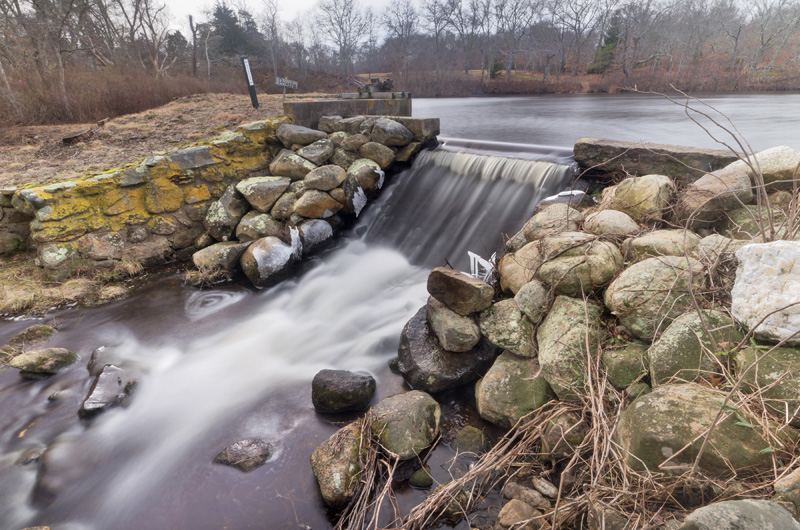The Martha’s Vineyard Commission is revising its 2007 water quality policy, with an eye toward stricter rules for developments that contribute nitrogen to saltwater ponds from wastewater.
Still in draft form, the policy marks a new phase in the commission’s efforts to protect Island ponds from the effects of development and land use changes. Nearly all the Island’s saltwater ponds have declined as new developments add nitrogen to the watersheds, causing algal blooms and loss of pond habitat.
As with the 2007 policy, the new draft notes that Massachusetts does not require septic systems to remove nitrogen, and that the commission seeks greater reduction goals than required by either the towns or state under board of health regulations.
The commission has broad powers to regulate development that go beyond what towns can do under planning and zoning laws.
Commission executive director Adam Turner discussed the draft with commissioners, staff members and others on Thursday, during a daylong series of meetings related to coastal ponds, held at the MVC headquarters in Oak Bluffs. Mr. Turner has made water quality a top priority for the commission since his arrival on the Island in 2015.
“We are looking at technologies that work, that are cost-effective and allow us to have some forms of development and protect the ponds,” Mr. Turner told the Gazette on Thursday. “The technology is improving greatly and we’re hoping that we’ll have solutions.”
The current water quality policy has been criticized for lagging behind the Massachusetts Estuaries Project, which recommends stricter nitrogen reduction goals for most Island ponds. A commission subcommittee began meeting last summer to revise the policy.
As before, the revisions aim to preserve Island ponds for recreation, fishing and shellfishing, and to maintain vital eelgrass beds. But the Massachusetts Estuaries Project now provides a more up-to-date foundation for the stricter requirements to limit nitrogen entering ponds.
An extensive status report included in the draft provides a profile of the 15 major Island estuaries, including the number of houses and the buildout potential in each watershed, the general condition of eelgrass beds, and the nitrogen limits per year as defined by the MEP. More than half of the ponds are impaired, according to the report, with five being somewhat impaired, and two (Menemsha Pond and Cape Pogue) in good condition.
The report includes basic remediation strategies for most of the ponds – including shellfish aquaculture, where nitrogen is removed through harvesting; and scheduled breachings to increase circulation. Expanded sewer connections are recommended for the Edgartown Great Pond, Lake Tashmoo and Oak Bluffs Harbor watersheds.
“It’s not one solution, it’s a package,” Mr. Turner said, calling the draft a framework for continued discussion as commissioners revise the policy. “You are going to have to meet some standards, but there will be flexible ways to do it.”
Unlike in 2007, the new draft proposes specific methods for mitigating nitrogen from commercial, institutional and agricultural projects.
Connecting to a town sewer “is clearly the preferred solution if it is available,” the policy states. But if that is not an option within 10 years of development, the policy encourages the connection of existing wastewater systems to offset the load. If neither option is available, the policy encourages the use of denitrifying septic systems or other on-site techniques to remove at least 40 per cent of the of the new nitrogen — the largest amount possible using commonly available systems.
The draft requires that fertilized lawns and gardens not exceed 10 per cent of a property area (or up to 4,000 square feet). Impervious surfaces may not exceed 25 per cent of a property area — or less for zone-2 areas of well contribution.
Perhaps the most dramatic new requirement is that projects in impaired watersheds, where the total nitrogen load exceeds the MEP limit, must either eliminate or offset their nitrogen contribution. To do so, developers may choose from three options:
• Connect to an existing sewer, and fully offset additional non-wastewater nitrogen by connecting abutters as well.
• If a sewer expansion is planned within 10 years, set aside funds to tie in the proposed development, and also enough abutters to account for 110 per cent of the projected nitrogen load.
• In the absence of planned sewer expansions, set aside funds to tie in enough properties within range of sewer service to reduce the new load by 110 per cent.
The draft policy does not yet clarify what the options would be for projects in watersheds such as those up-Island where there are no existing sewer connections, and where towns have no plans to develop municipal wastewater facilities.
Mr. Turner pointed to various options, including denitrifying toilets and permeable reactive barriers, which remove nitrogen in groundwater before it reaches the ponds. “There may be several different ways for a homeowner or somebody else to meet the policy standard,” he said.
A new section on agricultural projects lists a number of methods to minimize nitrogen loads as an alternative to meeting the standard requirements.
“Agriculture is a desirable land use offering open space and visual benefits to the community, supplying high-quality, locally produced food and stimulating the base of the economy,” the draft policy states. To qualify for the exemption, applicants may present an official USDA farm plan that addresses nutrient management and other impacts, become certified organic growers, or fulfill a list of water quality preservation techniques.
Some agricultural projects, including livestock yards, finfish farms and turf farms that produce sod for landscaping, may still be held to the normal water quality standards.
The draft adds a requirement for a site assessment under Chapter 21E of the state general laws for projects where previous uses involved hazardous materials. Projects that involve hazardous waste in significant quantities must provide a plan for handling and loss, and those in wellhead protection areas must install mechanical shut-off valves between the required catch basin and leaching area.
Also new in the draft policy is a list of 13 general guidelines for applications, including adequate depictions of land contours and water infrastructure, and plans related to groundwater, vegetation, maintenance and other features.
A section on fresh surface waters and groundwater has been expanded, with additional guidance related to private drinking wells, groundwater withdrawal, vernal pools and phosphorus (which in fresh water bodies has a similar effect as nitrogen). Among other things, applicants should use effluent drip-irrigation to increase phosphorus uptake in the soil, the draft states. The commission may require additional evaluation as well.
The commission’s agenda on Thursday included meetings of the water quality policy subcommittee and the Water Alliance, an Islandwide advocacy group. It wrapped up in the afternoon with a workshop featuring Eric Turkington, chairman of the Falmouth water quality management committee, and others from on and off the Island.
Tisbury board of health member Michael Loberg, who attended the Water Alliance meeting, said his board has received funding to test a new septic system design known as a “layer cake” at two locations in Tisbury, and is planning to apply for a state grant of up to $150,000 to test at least 10 experimental NitROE systems in the Lagoon Pond watershed. Both designs have been shown to remove about as much nitrogen as a sewage treatment plant, at a much lower cost.
Following a series of public hearings last year, the Tisbury board of health adopted new regulations that require denitrifying septic systems for new construction in the Lagoon Pond and Lake Tashmoo watersheds.
Mr. Turner said he expected a final draft of the policy by May 1, after which it will head to the full commission for review.









Comments
Comment policy »